Operators
 United Kingdom
United Kingdom
| Helicogyre | |
|---|---|
| Role | Experimental Helicopter |
| National origin | United Kingdom |
| Manufacturer | S.E. Saunders Limited |
| Designer | Vittorio Isacco |
| Number built | 1 |
The Saunders Helicogyre was a 1920s experimental helicopter designed by Vittorio Isacco and built by S.E. Saunders Limited for the British Air Ministry. [1]
Vittorio Isacco designed and built four different Helicogyre experimental helicopters between 1926 and 1935. In 1928 Air Ministry Specification 2/28 was issued to S.E Saunders for a prototype helicopter to the Helicogyre No. 3 design. [1]
The Helicogyre had a conventional 1920s tractor aircraft fuselage and main landing gear but had an extended tailskid to keep the fuselage horizontal. [1] At the front of the fuselage was a 100 hp (75 kW) Armstrong Siddeley Genet piston engine. [1] Behind the cockpit was a braced post on which was fitted a four-bladed rotor, each rotor blade was fitted with a 32 hp (24 kW) Bristol Cherub piston engine at the tip. [1]
The Helicogyre serial number K1171 was completed in 1929 and delivered to the Royal Aircraft Establishment at Farnborough by road. [1] It was tested in the Balloon Shed, [2] but ground tests were not completed and the programme was cancelled on 30 December 1931 without the Helicogyre having flown. [1]
Aircraft of comparable role, configuration, and era
Related lists

The Supermarine Spiteful was a British Rolls-Royce Griffon-engined fighter aircraft designed by Supermarine to Air Ministry specification F.1/43 during the Second World War as a successor to the Spitfire. It had a new wing design to improve its critical Mach number, and allow safe operations at higher speeds. The new design also had a modern inwards-retracting undercarriage. Other changes included a larger fin to improve the somewhat marginal stability of Griffon Spitfires and changes to the mounting of the engine to tilt it down slightly for better visibility over the nose.

The Blackburn B-20 was an experimental aircraft, first flying in 1940, that attempted to drastically increase the performance of flying boat designs. Blackburn Aircraft undertook an independent design study based on a patent filed by their chief designer, John Douglas Rennie for a retractable pontoon float that formed the planing hull.

The Blackburn Iris was a British three-engined biplane flying boat of the 1920s. Although only five Irises were built, it was used as a long-range maritime reconnaissance aircraft by the Royal Air Force, where it equipped a squadron for four years, being used to carry out a number of notable long-distance flights. The final version of the Iris, the Iris Mark V was developed into the aircraft that replaced it in Squadron service, the Blackburn Perth.

A tip jet is a jet nozzle at the tip of some helicopter rotor blades, used to spin the rotor, much like a Catherine wheel firework. Tip jets replace the normal shaft drive and have the advantage of placing no torque on the airframe, thus not requiring the presence of a tail rotor. Some simple monocopters are composed of nothing but a single blade with a tip rocket.
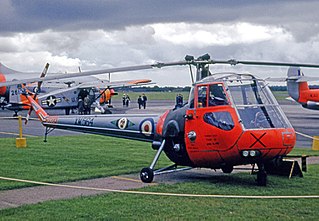
The Saunders-Roe Skeeter was a two-seat training and scout helicopter that was developed and produced by British manufacturer Saunders-Roe ("Saro") of Cowes and Southampton, in the United Kingdom.

The Bristol Type 173 was a British twin-engine, tandem rotor transport helicopter built by the Bristol Aeroplane Company. It was designed by Raoul Hafner as a civil transport helicopter but evoked interest from the military. It did not enter production but was developed into the Bristol Belvedere which was operated by the Royal Air Force from 1961 to 1969.

Pterodactyl was the name given to a series of experimental tailless aircraft designs developed by G. T. R. Hill in the 1920s and early 1930s. Named after the genus Pterodactylus, a well-known type of Pterosaur commonly known as the pterodactyl, all but the first were produced by Westland Aircraft Ltd after Hill joined them.
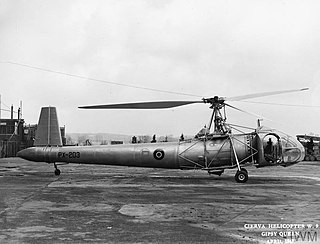
The Cierva W.9 was a British 1940s experimental helicopter with a three-blade tilting-hub controlled main rotor, and torque compensation achieved using a jet of air discharged from the rear port side of the fuselage.
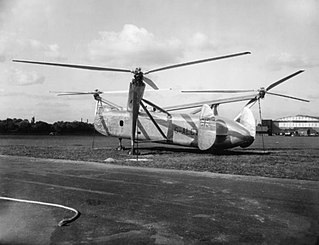
The Cierva W.11 Air Horse was a helicopter developed by the Cierva Autogiro Company in the United Kingdom during the mid-1940s. The largest helicopter in the world at the time of its debut, the Air Horse was unusual for using three rotors mounted on outriggers, and driven by a single engine mounted inside the fuselage.

The Percival P.74 was a British experimental helicopter designed in the 1950s that was based on the use of tip-jet powered rotors. Although innovative, the tip-rotor concept literally failed to get off the ground in the P.74, doomed by its inadequate power source. Rather than being modified, the P.74 was towed off the airfield and scrapped.

The Avro 604 Antelope was a British light bomber which was designed and built in the late 1920s to meet a requirement for a light bomber to equip the Royal Air Force, competing against the Hawker Hart and the Fairey Fox II. It was unsuccessful, the Hart being preferred.
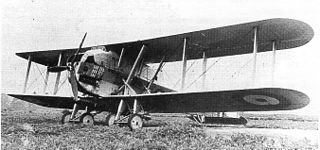
The Blackburn T.4 Cubaroo was a prototype British biplane torpedo bomber of the 1920s. Built by Blackburn Aircraft and intended to carry a large 21 in (533 mm) torpedo, the Cubaroo was one of the largest single-engined aircraft in the world at the time of its first flight.

The Bristol Bloodhound was a British two-seat reconnaissance/fighter aircraft designed and built by the Bristol Aeroplane Company as a possible replacement for the Bristol F.2 Fighter for the Royal Air Force. It was unsuccessful, only four prototypes being built.

The Cierva C.8 was an experimental autogyro built by Juan de la Cierva in England in 1926 in association with Avro. Like Cierva's earlier autogyros, the C.8s were based on existing fixed-wing aircraft fuselages – in this case, the Avro 552.

The Vickers Vendace was a 1920s British trainer aircraft. It was originally designed as a floatplane trainer for the Royal Air Force.

The Saro Cloud was a British passenger amphibian flying boat designed and built by Saunders-Roe as the A.19. It was later produced as the A.29 for the Royal Air Force for pilot and navigator training.

The Westland Westbury was a British twin-engined fighter prototype of 1926. Designed by Westland Aircraft it never entered service but played a useful role in the testing of the COW 37 mm gun. Only the two prototypes were completed.
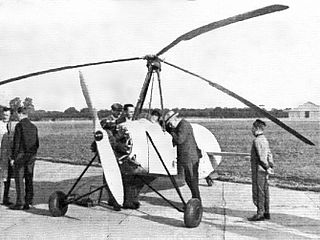
The Hafner A.R.III Gyroplane was a British 1930s experimental autogyro designed by Austrian Raoul Hafner, and built by the A.R.III Construction Company at Denham, Buckinghamshire.
The Blackburn F3 was a British single-engined fighter aircraft produced in response to Air Ministry Specification F.7/30.
The Flettner Gigant was an experimental helicopter built in Germany during the early 1930s.